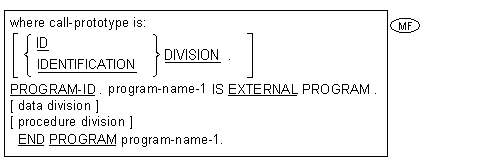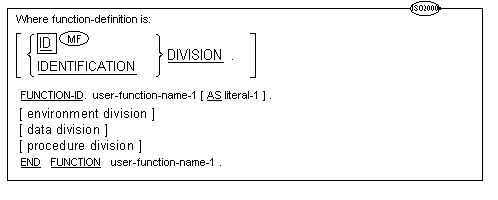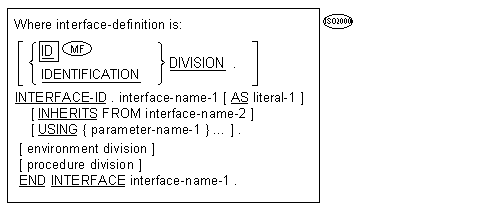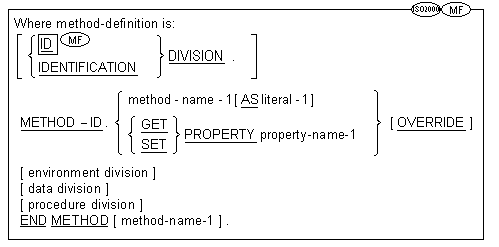

 | Concepts of a Compilation Group | Identification Division |  |
This part describes the base COBOL language definition.
The structure of the entire compilation group is described first. Each component of the compilation group is divided into four divisions.
Material is thus presented on the four divisions - the Identification Division, Environment Division, Data Division and Procedure Division. Within these divisions, material is presented according to COBOL sections, shown by the headers. Clauses, including intrinsic functions and COBOL verbs, are listed in alphabetical order, for ease of use.
Additional language features such as DBCS and Report Writer are supported, and are described in your companion manual, Language Reference - Additional Topics.
 A compilation group is a
series of source units. A source unit may contain other source units and
these contained source units may reference some of the resources of the
source units within which they are contained.
A compilation group is a
series of source units. A source unit may contain other source units and
these contained source units may reference some of the resources of the
source units within which they are contained.
 A compilation group may
contain zero, one, or more source units.
A compilation group may
contain zero, one, or more source units.
A source unit begins with an identification division and includes
any
 contained source units.
contained source units.
With the exception of
 compiler directives,
compiler directives,
source text manipulation statements, and
 end markers,
end markers,
the statements, entries, paragraphs, and sections of a source unit are
grouped into four divisions that are sequenced in the following order:
The beginning of a division in a source unit is indicated by the
appropriate division header. The beginning of the
 identification division may
also be indicated by one of the paragraph headers permitted in the
identification division.
identification division may
also be indicated by one of the paragraph headers permitted in the
identification division.
The end of a division in a source unit is indicated by one of the following:
 The end marker for that
source unit
The end marker for that
source unit The end of a source unit is indicated by an
 end marker, if specified, or
by the absence of additional source lines in the compilation group.
end marker, if specified, or
by the absence of additional source lines in the compilation group.
When a source unit, B, is
 contained in another source
unit, A, it may be directly or indirectly contained. Source unit B is
directly contained in source unit A if there is no source unit contained
in A that also contains B. Source unit B is indirectly contained in source
unit A if there exists a source unit contained in A that also contains B.
contained in another source
unit, A, it may be directly or indirectly contained. Source unit B is
directly contained in source unit A if there is no source unit contained
in A that also contains B. Source unit B is indirectly contained in source
unit A if there exists a source unit contained in A that also contains B.
A source unit that is directly or indirectly contained within another source unit is considered in these specifications as a separate source unit that may additionally reference certain resources defined in the containing source unit.
The object code resulting from compiling a source unit contained within another source unit is considered in these specifications to be inseparable from the object code resulting from compiling the containing source unit.
 A compilation unit is a
source unit that is not contained within another source unit. It may be
preceded or followed by other compilation units in a compilation group.
A compilation unit is a
source unit that is not contained within another source unit. It may be
preceded or followed by other compilation units in a compilation group.
A source element is a source unit excluding any nested source units.
A runtime element is the result of compiling a source element.
A runtime module is the result of compiling a compilation unit.








 call-prototypes and
call-prototypes and
 function-prototypes
function-prototypes
must precede all other types of source units.
 If a compilation group
contains both a function definition and a function prototype definition
with the same externalized name, the signatures of these two compilation
units must be the same.
If a compilation group
contains both a function definition and a function prototype definition
with the same externalized name, the signatures of these two compilation
units must be the same.
 The data division of a
method in a class definition must not contain a communication section.
The data division of a
method in a class definition must not contain a communication section.
 The data division of a
method is in interface definition can contain only a linkage section.
The data division of a
method is in interface definition can contain only a linkage section.
 The procedure division of a
method in an interface definition must contain only a procedure division
header.
The procedure division of a
method in an interface definition must contain only a procedure division
header.
 In a call prototype, the
procedure division header must conform to the rules for a format 2
procedure division header and any ENTRY statements must conform to the
rules for a format 2 ENTRY statement.
In a call prototype, the
procedure division header must conform to the rules for a format 2
procedure division header and any ENTRY statements must conform to the
rules for a format 2 ENTRY statement.
 In a call prototype, all
sections of the data division are ignored except for the linkage
section, and the procedure division is ignored except for the procedure
division header and ENTRY statements.
In a call prototype, all
sections of the data division are ignored except for the linkage
section, and the procedure division is ignored except for the procedure
division header and ENTRY statements.
 In a function prototype,
all sections of the data division are ignored except for the linkage
section, and the procedrue division is ignored except for the procedure
division header.
In a function prototype,
all sections of the data division are ignored except for the linkage
section, and the procedrue division is ignored except for the procedure
division header.

End markers indicate the end of a definition

 Function-prototype-name-1
must be identical to the function-prototype-name declared in the
corresponding FUNCTION-ID paragraph.
Function-prototype-name-1
must be identical to the function-prototype-name declared in the
corresponding FUNCTION-ID paragraph.
 User-function-name-1 must
be identical to the user-function-name declared in the corresponding
FUNCTION-ID paragraph.
User-function-name-1 must
be identical to the user-function-name declared in the corresponding
FUNCTION-ID paragraph.
 Class-name-1 must be
identical to the class-name declared in the corresponding CLASS-ID
paragraph.
Class-name-1 must be
identical to the class-name declared in the corresponding CLASS-ID
paragraph.
 Method-name-1 must be
identical to the method-name declared in the corresponding METHOD-ID
paragraph.
Method-name-1 must be
identical to the method-name declared in the corresponding METHOD-ID
paragraph.
 If the PROPERTY phrase is
specified in the METHOD-ID paragraph, method-name-1 shall be omitted.
If the PROPERTY phrase is
specified in the METHOD-ID paragraph, method-name-1 shall be omitted.
 Interface-name-1 must be
identical to the interface-name declared in the corresponding
INTERFACE-ID paragraph.
Interface-name-1 must be
identical to the interface-name declared in the corresponding
INTERFACE-ID paragraph.
Copyright © 2000 MERANT International Limited. All rights reserved.
This document and the proprietary marks and names
used herein are protected by international law.
 | Concepts of a Compilation Group | Identification Division |  |